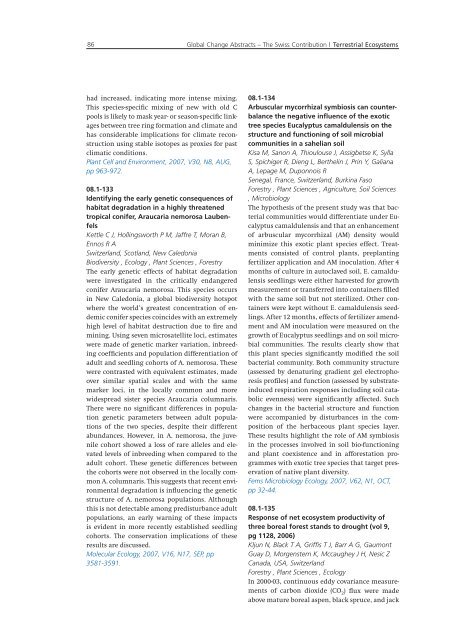Global Change Abstracts The Swiss Contribution - SCNAT
Global Change Abstracts The Swiss Contribution - SCNAT
Global Change Abstracts The Swiss Contribution - SCNAT
Create successful ePaper yourself
Turn your PDF publications into a flip-book with our unique Google optimized e-Paper software.
86<br />
had increased, indicating more intense mixing.<br />
This species-specific mixing of new with old C<br />
pools is likely to mask year- or season-specific linkages<br />
between tree ring formation and climate and<br />
has considerable implications for climate reconstruction<br />
using stable isotopes as proxies for past<br />
climatic conditions.<br />
Plant Cell and Environment, 2007, V30, N8, AUG,<br />
pp 963-972.<br />
08.1-133<br />
Identifying the early genetic consequences of<br />
habitat degradation in a highly threatened<br />
tropical conifer, Araucaria nemorosa Laubenfels<br />
Kettle C J, Hollingsworth P M, Jaffre T, Moran B,<br />
Ennos R A<br />
Switzerland, Scotland, New Caledonia<br />
Biodiversity , Ecology , Plant Sciences , Forestry<br />
<strong>The</strong> early genetic effects of habitat degradation<br />
were investigated in the critically endangered<br />
conifer Araucaria nemorosa. This species occurs<br />
in New Caledonia, a global biodiversity hotspot<br />
where the world’s greatest concentration of endemic<br />
conifer species coincides with an extremely<br />
high level of habitat destruction due to fire and<br />
mining. Using seven microsatellite loci, estimates<br />
were made of genetic marker variation, inbreeding<br />
coefficients and population differentiation of<br />
adult and seedling cohorts of A. nemorosa. <strong>The</strong>se<br />
were contrasted with equivalent estimates, made<br />
over similar spatial scales and with the same<br />
marker loci, in the locally common and more<br />
widespread sister species Araucaria columnaris.<br />
<strong>The</strong>re were no significant differences in population<br />
genetic parameters between adult populations<br />
of the two species, despite their different<br />
abundances. However, in A. nemorosa, the juvenile<br />
cohort showed a loss of rare alleles and elevated<br />
levels of inbreeding when compared to the<br />
adult cohort. <strong>The</strong>se genetic differences between<br />
the cohorts were not observed in the locally common<br />
A. columnaris. This suggests that recent environmental<br />
degradation is influencing the genetic<br />
structure of A. nemorosa populations. Although<br />
this is not detectable among predisturbance adult<br />
populations, an early warning of these impacts<br />
is evident in more recently established seedling<br />
cohorts. <strong>The</strong> conservation implications of these<br />
results are discussed.<br />
Molecular Ecology, 2007, V16, N17, SEP, pp<br />
3581-3591.<br />
<strong>Global</strong> <strong>Change</strong> <strong>Abstracts</strong> – <strong>The</strong> <strong>Swiss</strong> <strong>Contribution</strong> | Terrestrial Ecosystems<br />
08.1-134<br />
Arbuscular mycorrhizal symbiosis can counterbalance<br />
the negative influence of the exotic<br />
tree species Eucalyptus camaldulensis on the<br />
structure and functioning of soil microbial<br />
communities in a sahelian soil<br />
Kisa M, Sanon A, Thioulouse J, Assigbetse K, Sylla<br />
S, Spichiger R, Dieng L, Berthelin J, Prin Y, Galiana<br />
A, Lepage M, Duponnois R<br />
Senegal, France, Switzerland, Burkina Faso<br />
Forestry , Plant Sciences , Agriculture, Soil Sciences<br />
, Microbiology<br />
<strong>The</strong> hypothesis of the present study was that bacterial<br />
communities would differentiate under Eucalyptus<br />
camaldulensis and that an enhancement<br />
of arbuscular mycorrhizal (AM) density would<br />
minimize this exotic plant species effect. Treatments<br />
consisted of control plants, preplanting<br />
fertilizer application and AM inoculation. After 4<br />
months of culture in autoclaved soil, E. camaldulensis<br />
seedlings were either harvested for growth<br />
measurement or transferred into containers filled<br />
with the same soil but not sterilized. Other containers<br />
were kept without E. camaldulensis seedlings.<br />
After 12 months, effects of fertilizer amendment<br />
and AM inoculation were measured on the<br />
growth of Eucalyptus seedlings and on soil microbial<br />
communities. <strong>The</strong> results clearly show that<br />
this plant species significantly modified the soil<br />
bacterial community. Both community structure<br />
(assessed by denaturing gradient gel electrophoresis<br />
profiles) and function (assessed by substrateinduced<br />
respiration responses including soil catabolic<br />
evenness) were significantly affected. Such<br />
changes in the bacterial structure and function<br />
were accompanied by disturbances in the composition<br />
of the herbaceous plant species layer.<br />
<strong>The</strong>se results highlight the role of AM symbiosis<br />
in the processes involved in soil bio-functioning<br />
and plant coexistence and in afforestation programmes<br />
with exotic tree species that target preservation<br />
of native plant diversity.<br />
Fems Microbiology Ecology, 2007, V62, N1, OCT,<br />
pp 32-44.<br />
08.1-135<br />
Response of net ecosystem productivity of<br />
three boreal forest stands to drought (vol 9,<br />
pg 1128, 2006)<br />
Kljun N, Black T A, Griffis T J, Barr A G, Gaumont<br />
Guay D, Morgenstern K, Mccaughey J H, Nesic Z<br />
Canada, USA, Switzerland<br />
Forestry , Plant Sciences , Ecology<br />
In 2000-03, continuous eddy covariance measurements<br />
of carbon dioxide (CO 2) flux were made<br />
above mature boreal aspen, black spruce, and jack

















